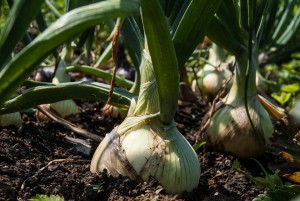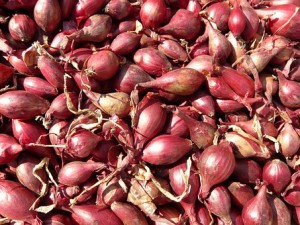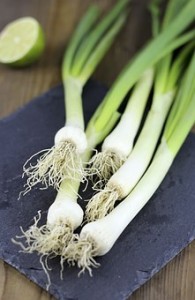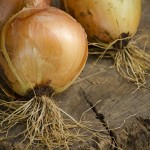We use cookies to make your experience better. To comply with the new e-Privacy directive, we need to ask for your consent to set the cookies. Learn more.
All About Onions

The onion has been grown and selectively bred in cultivation for at least 7,000 years. Onions are part of the allium family - along with shallots, garlic and leeks.
Onion Sets
Onion sets are available as white or red for spring planting and as white onions for autumn planting. (Onion Sets are grown by sowing onion seed thickly late in the summer. The plants are allowed to grow just until they start forming bulbs. These immature bulbs are dug, cured like regular onions, then held in temperature-controlled warehouses until spring, when they are sold as onion sets).
For the biggest summer onions, plant early (March-April). You can plant onions as soon as the soil is dry enough to work.
The onion lifecycle is “photoperiodic”, which means it is sensitive to day length. Most onions will make top growth (the green part above the ground) until a critical day length is reached, triggering bulbing. Bulbing generally begins when there is about 14 hours of light per day. If you plant your onions in the early spring, they will be fairly large plants when the days get 14 hours long. Large bulbs will be the result. If you wait to plant your onions until the end of April, when days reach 14 hours, bulbing will begin immediately and smaller onions will be the result.

How to plant
The size of the bulb is dependent on early planting, as well as the adequate supply of water and nutrients. Onions should be grown in full sun, in fertile, moist and well drained soil. Onions like most vegetables are quite demanding for Potash(K), medium for Phosphorus(P) and medium for Nitrogen(N). A good all-round fertilizer is ideal for them. Well broken down FYM or compost is essential for strong balanced growth. For scallions or small green onions, plant the sets 5 cm deep and 3cm apart. They will be ready for eating in about a month when the tops reach 20-25cms. For larger onions, plant the sets about a 1-1.5cm deep and 10 cm apart.
Aftercare
Onions should be regularly hoed as they don’t like competition from weeds. Onions are shallow-rooted, so if allowed to dry out, they could bulb early and then you will have small onions.
Harvesting
Stop watering your onions when they reach the desired size and the tops have begun to fall over. Harvest them when most of the tops are down. Sun-cure them for at least a week before storing to make them last longer. After that make ropes out of them or store them in net bags hanging in a cool, dry place.
Overwintering onion sets can be planted in September-October for harvest next June or July. These can be harvested as scallions all season long.

Red Onions
Red onions are milder than white and are often used in salads or salsa. They also make a very good garnish due their attractive colouring. Grow as white onions. Will keep well if properly ripened and dried.
Onions from Seed
Onions can also be grown from seed. It is important to use fresh seed and to allow enough time for germination. Start them off in late February/early March in a sheltered place/polytunnel so that they will be a good size when you come to plant them out in April. As they grow, your baby onions will flop over into a tangled mess. To grow sturdy plant with strong root systems, use a scissors (or just pinch them with your fingertips) to keep the plants trimmed to around 10cm tall. The trimmings can be used in salads or as a garnish.
Growing onions from seed will give you more choice of varieties. We stock Robelja (red) and Sturon (white).

Spring/Bunching Onions
Also known as scallions or green onions, spring onions are in fact very young onions, harvested before the bulb has had a chance to swell. Both the long, slender green tops and the small white bulb are edible, and are good either raw or cooked. They have a similar flavour to onions, but are much milder. Successionally sow each week or two from early March for a continuous supply throughout the summer.

